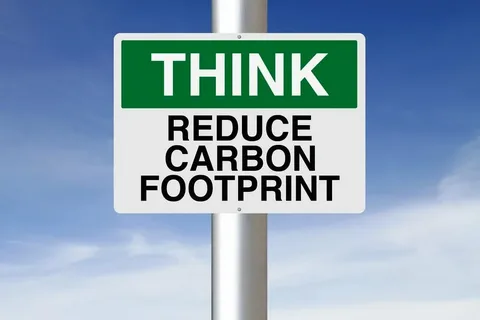Carbon Footprint Reduction: Strategies for a Sustainable Future
The concept of a “carbon footprint” refers to the total amount of greenhouse gases (GHGs) emitted into the atmosphere due to human activities. These emissions, primarily carbon dioxide (CO2), contribute to global warming and climate change.

Reducing our carbon footprint is essential to mitigating the effects of climate change and building a sustainable future for the planet. In this article, we will explore various strategies that individuals, businesses, and governments can implement to reduce their carbon footprints and promote environmental sustainability.
What is a Carbon Footprint?
A carbon footprint measures the amount of carbon dioxide and other GHGs that are released into the atmosphere as a result of everyday activities such as driving a car, using electricity, or producing goods and services. Carbon footprints can be categorized into two main types:
- Individual Carbon Footprint: This refers to the emissions associated with an individual’s lifestyle, including energy consumption, transportation, food choices, and waste generation.
- Corporate or Organizational Carbon Footprint: This refers to the emissions produced by businesses and organizations through their operations, supply chains, and production processes.
The Impact of Carbon Emissions

The emission of greenhouse gases, particularly CO2, is the primary driver of global warming. These gases trap heat in the atmosphere, leading to rising global temperatures, melting ice caps, extreme weather events, and rising sea levels. Reducing carbon emissions is a critical step toward limiting the extent of climate change and protecting the planet’s ecosystems and human populations.
Why Is Reducing Your Carbon Footprint Important?
Reducing your carbon footprint is essential for several reasons:
- Combating Climate Change: By reducing emissions, we can slow down the pace of climate change and avoid the worst impacts such as extreme weather events, droughts, and rising sea levels.
- Improving Public Health: Reducing carbon emissions also leads to cleaner air and fewer pollutants, which benefits human health by reducing respiratory and cardiovascular diseases.
- Energy Independence: By decreasing reliance on fossil fuels, individuals and countries can increase energy security and move toward more sustainable energy sources, such as solar, wind, and geothermal energy.
- Economic Benefits: Adopting low-carbon practices often leads to cost savings through increased energy efficiency and waste reduction.
How to Reduce Your Carbon Footprint
There are many strategies that individuals, businesses, and governments can adopt to reduce their carbon footprints. Here are some of the most effective approaches:
1. Switch to Renewable Energy Sources
One of the most impactful ways to reduce your carbon footprint is by transitioning to renewable energy sources, such as solar, wind, and hydropower. Fossil fuels like coal, oil, and natural gas are responsible for a significant portion of global CO2 emissions. By replacing these with renewable energy, we can drastically reduce the amount of greenhouse gases released into the atmosphere.

For individuals, this could mean installing solar panels on your home or using green energy plans from your utility provider. For businesses, investing in renewable energy solutions or purchasing renewable energy certificates (RECs) can help offset emissions from energy consumption.
2. Increase Energy Efficiency
Improving energy efficiency is one of the most cost-effective ways to reduce carbon emissions. Energy-efficient buildings, appliances, and vehicles consume less energy, which means fewer emissions are produced. Individuals can reduce their energy consumption by upgrading to LED lights, using energy-efficient appliances, and improving home insulation.
For businesses, energy-efficient office equipment, heating, and cooling systems, as well as adopting energy-saving practices, can lead to significant reductions in their carbon footprint. Industrial sectors can also benefit from improving energy efficiency in manufacturing processes.
3. Adopt Sustainable Transportation Methods
Transportation is a major source of carbon emissions, particularly from fossil-fuel-powered vehicles. One of the best ways to reduce transportation-related emissions is by shifting to electric vehicles (EVs). EVs produce zero tailpipe emissions and can be powered by renewable energy, making them a much cleaner alternative to traditional gasoline or diesel-powered cars.
Additionally, using public transportation, carpooling, walking, or cycling instead of driving alone can significantly reduce emissions. For businesses, encouraging employees to use sustainable transportation options and providing incentives for carpooling or biking can further reduce carbon footprints.
4. Reduce, Reuse, and Recycle
Waste management plays a crucial role in reducing carbon emissions. Landfills are a significant source of methane, a potent greenhouse gas. Reducing the amount of waste you produce, reusing items when possible, and recycling materials can help prevent emissions from waste disposal.
At the individual level, people can reduce their carbon footprint by buying fewer disposable items, recycling paper, plastic, and glass, and composting organic waste. For businesses, implementing waste reduction programs, recycling initiatives, and sustainable packaging solutions can also help minimize emissions.
5. Eat a More Plant-Based Diet
The food we eat has a significant impact on our carbon footprint, especially when it comes to the production of meat and dairy products. Livestock farming generates large amounts of methane and requires vast amounts of land, water, and resources. By reducing meat and dairy consumption and adopting a more plant-based diet, individuals can lower their carbon footprints.
For businesses in the food industry, offering plant-based options and reducing food waste can contribute to a more sustainable food system. Additionally, sourcing locally produced foods can reduce the carbon footprint associated with transportation and food imports.
6. Support Sustainable Practices in Agriculture
Agriculture is another significant contributor to greenhouse gas emissions, primarily through methane emissions from livestock and nitrous oxide from fertilizers. Supporting sustainable agriculture practices, such as organic farming, agroforestry, and crop rotation, can help reduce emissions from food production.
Individuals can support sustainable agriculture by buying organic products, sourcing food from local farmers, and choosing products with eco-friendly certifications. Businesses can adopt sustainable farming practices in their supply chains to reduce the carbon footprint of their products.
7. Plant Trees and Protect Forests
Trees are natural carbon sinks, meaning they absorb and store carbon dioxide from the atmosphere. Reforestation and afforestation (planting new forests) are critical strategies for reducing carbon emissions. By planting trees and protecting existing forests, we can offset emissions and help combat climate change.
Individuals and businesses can contribute to reforestation efforts by participating in tree planting initiatives, supporting organizations dedicated to forest conservation, and reducing paper consumption.
8. Implement Carbon Capture and Storage (CCS) Technology
Carbon capture and storage (CCS) is a technology that involves capturing CO2 emissions from power plants, industrial facilities, and other sources and storing them underground or in other secure locations. This technology has the potential to significantly reduce emissions from industries that are difficult to decarbonize.
Governments and businesses can invest in CCS technology to help mitigate emissions, particularly from sectors like cement and steel production, where emissions are hard to eliminate completely.
9. Advocate for Climate Policy and Regulations
One of the most powerful ways to reduce carbon emissions is through government policy and regulations. Governments play a crucial role in setting emissions standards, promoting renewable energy, and incentivizing low-carbon technologies. Individuals and businesses can advocate for stronger climate policies, support carbon pricing mechanisms, and push for renewable energy initiatives.
By working together, we can create the political will needed to enact large-scale changes that drive carbon reduction efforts.
10. Educate and Raise Awareness
Finally, raising awareness and educating others about the importance of carbon footprint reduction can have a profound impact. The more people understand the connection between their actions and the environment, the more likely they are to adopt sustainable practices. Communities, businesses, and governments can invest in educational campaigns, workshops, and programs to help others reduce their carbon footprints.
Conclusion
Reducing your carbon footprint is an essential step toward mitigating climate change and creating a sustainable future. By adopting renewable energy sources, improving energy efficiency, promoting sustainable transportation, and supporting responsible consumption practices, we can collectively work toward lowering emissions. Whether you are an individual, business, or government, every action counts in the fight against climate change. Together, we can make a difference and help protect the planet for future generations.
Leave a Reply